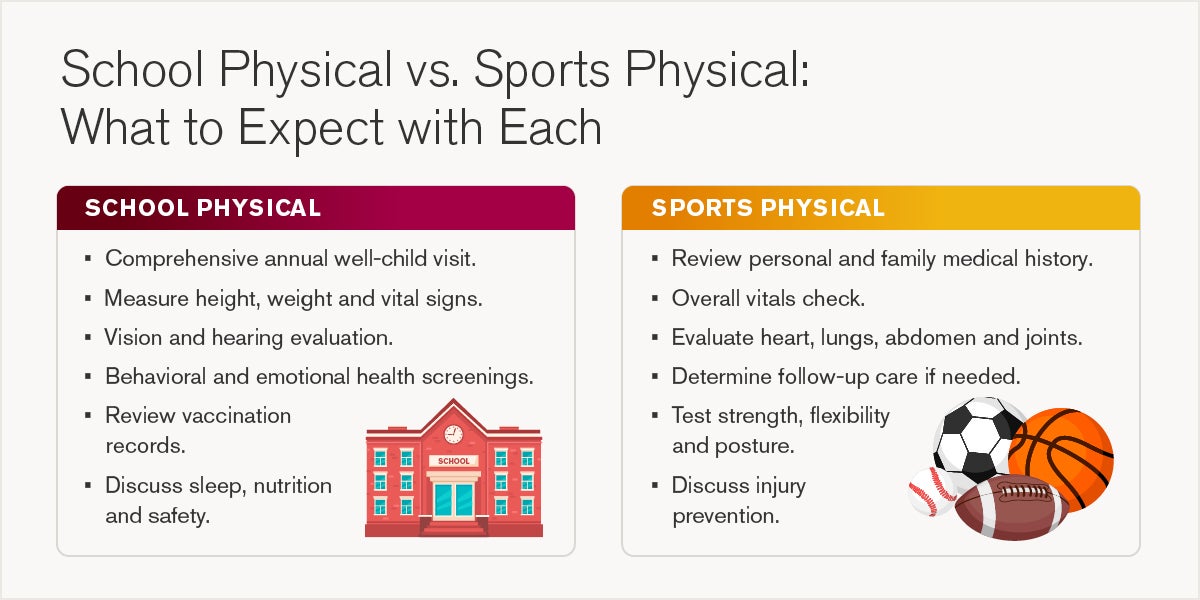School Physical vs. Sports Physical: What Parents Need to Know
July 8, 2025
Categories: Family Medicine, Pediatrics, Sports Medicine
By: Jolene M Quinones, APRN | Family Medicine
As the school year approaches, many parents find themselves juggling doctor visits, tracking down school supplies, and filling out athletic paperwork. For many parents, this time of the year is confusing and disorganized, especially if they don’t understand the difference between school and sports physicals. To clear up the confusion, Jolene Quinones, a family nurse practitioner at Loyola Medicine, has provided expert guidance to help parents prepare and stay informed.
What happens at a school physical?
A school physical, also known as a well-child visit, is a comprehensive checkup that assesses your child’s overall health and development, typically required when a child enters a new school or a specific grade. Annual physical exams are recommended by pediatric health experts for the overall well-being of your child, and are often required by school districts.
A school physical may include:
- A full health history and developmental screening
- Height, weight, and vital signs
- Vision and hearing screening
- Behavioral and emotional health evaluation
- A review of vaccination records
- Health discussions about sleep, nutrition, and safety
“These exams are an opportunity to evaluate your child’s health in a holistic way,” says Quinones. “It’s more than just a quick check. It’s a time to make sure they’re on track developmentally.”
What is included in a sports physical?
A sports physical is required by most schools and leagues before a child can play organized sports. The goal is to identify any medical concerns that might prevent a child from safely participating in athletic activities.
A sports physical typically includes:
- A review of personal and family medical history
- Evaluation of heart and lung function
- Assessment of muscle and joint strength, flexibility, and alignment
- Reflex and coordination tests
- Hernia screening for male athletes
- Past injury review and discussion of injury prevention
“We do specific activities like duck walking or toe walking to test muscle function,” Quinones explains. “We’re also checking for heart murmurs, especially during or after light exertion, which wouldn’t be part of a typical school exam.”
Can one physical cover both school and sports requirements?
Many parents lead busy lives and want to combine school and sport physicals into one trip to the doctor’s office. However, this may not always be possible or the best option. In some cases, a health care provider may be able to complete both in a single appointment, but it’s recommended to schedule them separately to ensure thoroughness. Having two appointments, one for each physical, will make it easier to spot potential health conditions.
If you want to combine both into one appointment, be sure to check with your child’s school and sports organization to verify whether one form can satisfy both requirements.

When should I schedule a school or sports physical?
The best time to schedule school and sports physicals is early in the summer, before the rush of back-to-school appointments in July and August. While it may be tempting to schedule these physicals closer to the start of school, many parents have the same idea. You may end up in a situation where you’re rushing to find an appointment.
These general guidelines may help you plan when both physicals are due:
- School physicals are usually required when entering preschool, kindergarten, 6th grade, and high school or when transferring to a new school.
- Sports physicals are typically required annually and must be dated within 365 days of the first day of practice or tryouts.
Planning early gives you time to follow up if your child needs additional evaluations or vaccines. Many medical centers offer walk-in school and sports physicals to save parents time and money.
What health conditions are children screened for during a sports physical?
Both school and sports physicals are important for identifying medical concerns, but sports physicals may catch conditions that affect safe participation in sports, such as:
- Heart murmurs
- Undiagnosed scoliosis
- Joint or muscular imbalances
- Past injuries that may need follow-up care
“If we detect a murmur, the child won’t be cleared until they’re evaluated by a cardiologist,” says Quinones. “Same goes for orthopedic or neurological concerns. We want to make sure every child is safe to play.”
How to prepare for your child’s school physical
To make the most of the appointment and help things go as quickly and smoothly as possible, here’s how parents can prepare:
- Bring your child’s immunization records, especially if they’re new to the clinic.
- Prepare your child for what to expect during the exam, including the possibility of vaccines.
- Write down questions ahead of time for your provider to answer during the visit.
- Check your insurance plan. Most cover one well-child visit and one sports physical per year, spaced at least 365 days apart.
Planning ahead is the key to getting your child’s forms in on time. “I’ve personally spoken to many families trying to get an appointment the day their form is due or even right before a game. Sometimes we can accommodate these requests, but many times we can’t,” says Quinones. “The earlier you schedule, the smoother it goes.”
Jolene Quinones, APRN, is a board-certified Family Nurse Practitioner at Loyola Medicine. Known for her compassionate care and strong communication, she provides primary and acute care to patients of all ages. Dr. Quinones is highly rated by patients for her attentiveness, clear explanations, and commitment to patient well-being.
